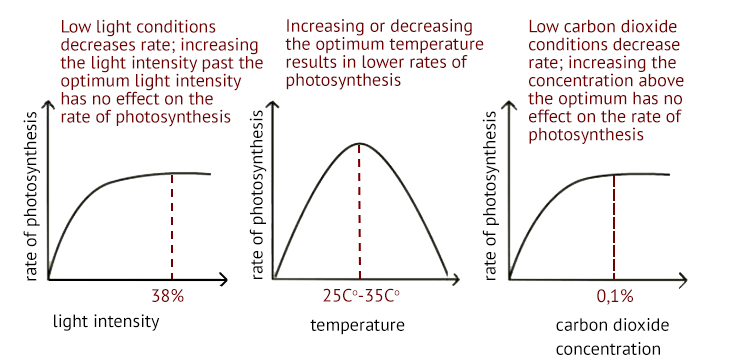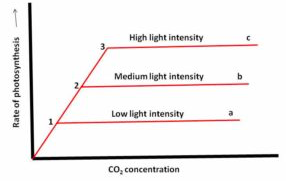Photosynthesis
Photosynthetic Organisms
Photosynthetic organisms are the main producers of food. Green plants are producers, as they can make their own food from the raw materials around them by a process called photosynthesis.
- During photosynthesis radiant energy from the sun (sunlight) is absorbed by green plants.
- The energy is used to convert carbon dioxide, water and minerals the plants take in from their surroundings into sugar and gaseous oxygen.
- Photosynthesis is an endothermic reaction, meaning that energy is taking in from the surroundings and the temperature of the surroundings decreases.
Photosynthesis occurs in the leaf.
Needs:
- Chlorophyll – not used up
- CO2 (from the air)
- Water (from the soil)
- Sunlight energy (any light except green light) – not used up
Produces:
- Glucose
- Oxygen (waste product)
Limiting Factors
The rate of photosynthesis is affected by three main factors:
- temperature
- light intensity
- carbon dioxide concentration
A limiting factor__ __is any factor that slows down the rate of photosynthesis if there is not enough of it. It is called a limiting factor because it “limits” the reaction from taking place.
- __Light Intensity __- Without enough light a plant cannot photosynthesise very fast, even if there is plenty of water and carbon dioxide. Increasing the light intensity will make photosynthesis faster.
- __Carbon dioxide level __- Photosynthesis can be limited by the level of carbon dioxide. Even if there is plenty of light a plant cannot photosynthesise if it has run out of carbon dioxide.
- Temperature - If it gets too cold the rate of photosynthesis will slow right down. If it gets too hot then plants cease to be able to photosynthesise.
Each factor does not work in isolation, as each factor has an affect on the rate of photosynthesis. Several factors may interact, and it may be any one of them that is limiting photosynthesis.
The rate of photosynthesis will increase until there is a limiting factor (which could be any of the three above).
For example, if the light intensity increases, then the rate of photosynthesis will increase until there is another limiting factor. The rate may increase as the temperature increases as well. This will keep happening until another factor becomes the new limiting factor.
This graph shows how the rate of photosynthesis increases as the carbon dioxide concentration increases. However the higher the light intensity, the higher the rate of photosynthesis. This would suggest that an increase in light intensity and carbon dioxide would increase the rate of photosynthesis, until it levels off.
Inverse Square Law
The rate of photosynthesis is directly proportional to light intensity and inversely proportional to the distance from a light source.
The intensity of light at different distances from a light source can be described by the inverse square law. The inverse square law tells us that the intensity of light is inversely proportional to the square of the distance from the source.
Therefore when the light is moved twice as far from the plant it will receive a quarter of the energy. This can be calculated with the following formula:
∝ means ‘is proportional to’, and distance is measured in metres.
- List three limiting factors for photosynthesis.
- Your answer should include: Light intensity / temperature / carbon dioxide concentration.
- What is a producer?
- Your answer should include: Living Organism / Food / Raw Materials / Photosynthesis
Explanation: Living organism that can make their own food from the raw materials around them by a process called photosynthesis - What is the equation for photosynthesis?
- Your answer should include: Carbon Dioxide / Water / Oxygen / Glucose
Explanation: Carbon dioxide + water → oxygen + glucose



